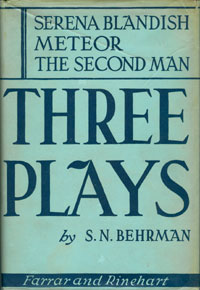|
 |
Three Plays
S. N. Behrman
New York:
Farrar & Rinehart, 1934
First edition in dust jacket
Inscribed by Behrman |
| |
|
(On front free endpaper)
For Sam Marx / My chieftain and /
friend. / From / S.N.B. / Hollywood: March, 1935.
First appearance of Serena
Blandish. Also includes Meteor and
The Second Man. Samuel Marx was the head of the
Metro-Goldwyn-Mayer story department. |
|
|
Serena Blandish, which opened in New York in 1929,
presents a leading character emerging from an environment
somewhat similar to Clark Storeyís in The Second Man,
but one who achieves something of a reverse denouement. In a
Pygmalion-like situation, Serena follows her romantic
heart to find happiness. This idealism softens the razorís
edge of the sheer mercenary exemplified by Clark Storey; his
cynicism is blunted. Moreover, Serena Blandish begins
to substantiate areas of concern which will appear in all of
Behrmanís plays in varying degree: success (in the Horatio
Alger mold, which so captivated his childhood fancy),
wealth, love, and marriage. The first suggestion of a
conflict between generations, developed more fully in later
plays, particularly in The Talley Method (1941), I
Know My Love (1949), Lord Pengo (1962), and
But For Whom Charlie (1964), insinuates itself in the
peculiar father-son relationship of Martin and Edgar
Malleson. Tempering such conflict in Behrmanís oeuvre is his
endorsement of humane sensibility and tolerance. Serena
Blandish; or The Difficulty of Getting Married, a novel
written by "A Lady of Quality" (later revealed to be
Englandís Enid Bagnold) came to Behrmanís attention through
an associateís interest in the work. The novel suited the
playwright admirably, and it remained largely a problem of
finding a theatrically viable ending quite different from
the novel wherein Serena marries a Negro. Such an ending
Behrman determined as too inflammatory a resolution for the
late 1920s and not without reason. "That the play was to be
produced in a country where Negroes, often only merely
suspected of a crime, are dragged through the streets by
mobs of children and grown-ups and maltreated and burned
alive or lynched, gives me a legitimate defence of simple
and justifiable cowardice." The ingenuous Serena is a "good
sport," totally defenseless, and every man who comes along
exploits her. One afternoon Serena is swept up in a business
proposition: for a period of thirty days she will be
introduced to the wealthiest, most eligible bachelors in
London society. She is to capitalize on this arrangement and
to make a "suitable connection." The outcome is predictable
as Serena falls in love with a farthingless, low achiever,
Edgar Malleson (himself the designated predator of Princess
Vermouillť, from whom he later flees), and even he will not
marry Serena. Her unsullied naivetť still intact at the
completion of this experiment, Serena follows Edgar to the
Continent where he is to involve himself in a business
venture almost certain to fail. Although Serenaís penury
permits the playwright to manipulate her rather like a
puppet, she is still very much her own person and
represents, in the largest sense possible, the first of
Behrmanís independent females whose mature incarnations are
Biographyís Marion Froud (1932) and Lady Lael Wyngate
of Rain From Heaven. The other characters,
particularly the Countess Flor di Folio (who resembles an
erudite Mrs. Malaprop of Richard Brinsley Sheridanís The
Rivals) tend to fall into the archetypal
comedy-of-manners contour. Producer Jed Harris brought the
young Ruth Gordon to stardom as Serena. Her out-of-wedlock
pregnancy by Harris, recounted in Gordonís autobiography,
may offer an explanation for the abbreviated run. However,
its ninety-three performances alerted the Theatre Guild, who
had turned down first option on Behrmanís manuscript, to
re-evaluate their interest in the playwright. They
determined not to let his next offering pass them by. |
|